![]()
![]()
![]()
Use LEFT and RIGHT arrow keys to navigate between flashcards;
Use UP and DOWN arrow keys to flip the card;
H to show hint;
A reads text to speech;
47 Cards in this Set
- Front
- Back
|
What part of a EKG precedes isovolumetric contraction?
|
The QRS complex
|
|
|
What signals the start of systole in a EKG?
|
The R peak
|
|
|
When does the mitral valve close?
|
When ventricular pressure exceeds left atrial pressure
|
|
|
What is the first heart sound?
|
Closure of the mitral valve
|
|
|
When does the aortic valve open?
|
When left ventricular pressure exceeds aortic pressure
|
|
|
When does the rapid ejection phase begin?
|
When the aortic valve opens
|
|
|
When does rapid ejection occur on a EKG?
|
During the ST segment
|
|
|
What is the stroke volume? How do you calculate SV?
|
The volume of blood that flows into the aorta per beat
SV = EDV - ESV |
|
|
What is the ejection fraction? how do you calculate it?
|
The fraction of blood ejected by the ventricle relative to its end-diastolic volume
EF = SV/EDV |
|
|
What is the cardiac output? How do you calculate it?
|
The volume of blood pumped by the heart per minute
CO = SV x HR |
|
|
What wave on the EKG coincides w/ a reduction in LV contraction and pressure?
|
The T wave
|
|
|
Why does the aortic valve not immediately close when LV pressure drops?
|
B/c of the inertia of the blood flow, which imparts considerable kinetic energy
|
|
|
What propels blood into the peripheral circulatory system?
|
Elastic recoil of arteries
|
|
|
What is the end-systolic volume?
|
The volume of blood left in the ventricle after systole
|
|
|
What closes the aortic valve?
|
Aortic elastic recoil causes blood to flow toward the ventricles (retrograde or negative flow) leading to aortic valve closure
|
|
|
What defines the onset of diastole?
|
Aortic valve closure
|
|
|
What causes the S2?
|
Aortic and pulmonary valve closure
|
|
|
What causes the dichrotic notch in the aortic pressure waveform?
|
Closure of the aortic valve which results in brief forward flow in the aorta
|
|
|
When are both the mitral and aortic valves closed and no blood is entering the LV?
|
Isovolumetric relaxation
|
|
|
What causes pressure in the LV to drop rapidly?
|
Isovolumetric relaxation occurs b/c both valves are closed and no new blood is entering the ventricle
|
|
|
When does the rapid ventricular filling phase begin?
|
When ventricular pressure falls below atrial pressure
|
|
|
When does the mitral valve open?
|
When ventricular pressure falls below atrial pressure
|
|
|
When are the atrial and ventricular pressures the same?
|
During rapid filling, when the aortic valve is closed but the mitral valve is open
|
|
|
What drives the rise in pressure seen in the left ventricle and left atrium during reduced ventricular filling?
|
Pressure in the pulmonary veins
|
|
|
Where in the cardiac cycle does the P wave occur? what happens during the P-wave?
|
At the end of reduced ventricular filling
Atrial contraction |
|
|
What is the end-diastolic volume?
|
The left ventricular volume at the end of atrial contraction
|
|
|
What is the left-ventricular end-diastolic volume?
|
The pressure in the ventricle at the end of diastole
|
|
|
What is a characteristic of a compliant left-ventricle?
|
Pressure in the left ventricle does not increase significantly even after ventricular filling
|
|
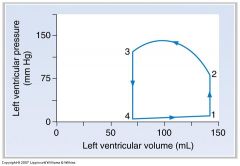
1. Where does the mitral valve open?
2. Where is rapid filling? 3. Where does the mitral valve close? 4. Where does ventricular filling end? 5. Where is isovolumetric contraction? 6. Where does the aortic valve open? 7. Where is rapid ejection? 8. Where is reduced ejection? 9. Where is end-systolic volume? 10. Where does the aortic valve close? 11. where is isovolumetric relaxation? 12. Where is end-diastolic volume? 13. Where is stroke volume? |
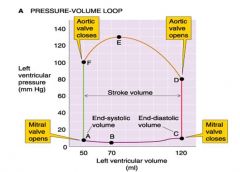
1. A
2. A-B 3. C 4. C 5. C-D 6. D 7. D-E 8. E-F 9. F 10. F 11. F-A 12. C 13. on graph |
|
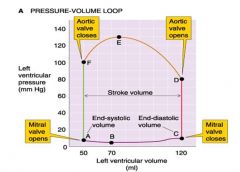
What segment reflects a high compliance in LV?
|
B-C, b/c there is only a slight increase in pressure despite a significant increase in volume
|
|
|
What is the main difference b/e the left and right heart?
|
The magnitude of peak systolic pressure only reaches ~24mmHg in the right heart
|
|

1. What is the a-wave on the JVP?
2. What is the c-wave? 3. What is the v-wave? |
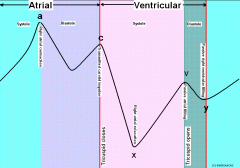
1. Contraction of right atrium
2. Bulging of the tricuspid valve into the right atrium as right ventricular pressure rises during systole 3. filling of the right atrium against a close tricuspid valve |
|
|
How do you calculate cardiac output using the fick equation?
|
Q = VO2 / [(Ca)-(Cv)]
|
|
|
How do you calculate the O2 in venous blood entering the lungs per minute?
|
=QCv
|
|
|
How do you calculate the O2 in arterial blood leaving the lungs per minute?
|
=QCa
|
|
|
How do you calculate the O2 uptake by pulmonary capillaries per minute?
|
(QCa)-(QCv)
|
|
|
How do you calculate VO2?
|
VO2=(QCa)-(QCv)
|
|
|
What is the first/last phase of diastole?
|
first = isovolumetric relaxation
last = atrial systole |
|
|
What is the first/last phase of systole?
|
first = isovolumetric contraction
last = reduced ejection |
|
|
What causes ventricular relaxation?
|
Removal of calcium from the cytosol
|
|
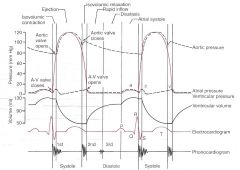
Which part of the graph reflects diastolic blood pressure? systolic?
|
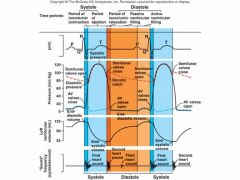
|
|
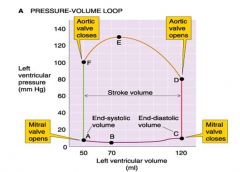
If the A-B segment rises how will that affect LV volume? What would cause segment A-B to rise?
|
Decrease it b/c the mitral valve will close faster
Decreased ventricular compliance |
|
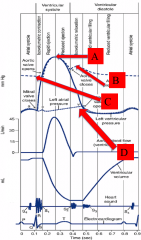
Which point most closely depicts diastolic blood pressure?
|
C
|
|
|
Your blood pressure this morning is 124/76. If the denominator increased to 100 mm Hg, which phase of the cardiac cycle will be prolonged? why?
|
Isovolumetric contraction; b/c the left ventricle will have to reach a higher pressure in order to overcome the pressure in the aorta and open the aortic valve
|
|
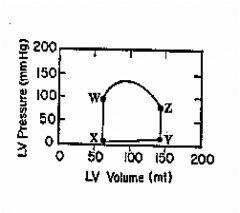
A 54 year old woman has a resting cardiac output of 7 liters/min. Her arterial pressure is 125/85 and her body temp is normal. The diagram below is the pressure-volume curve of her left ventricle. What is her heart rate?
|
Step 1: Calculate SV
EDV-ESV = 150-50 = 90mL Step 2: Calculate EF SV / EDV = 90/150 mL = 60% Step 3: Calculate HR CO = HR x SV => 7000 mL/min = HR x 90mL => HR = 7000/90mL = 78 bpm |
|
|
a resting human absorbs ~250 ml O2 per minute from alveolar gas (VO2). Arterial blood contains 195 ml O2 per liter and mixed venous blood contains 145 ml O2 per liter. What is Q?
|
Q = 250/(195-145) = 5 L/min
|
|
|
What is the pulmonary capillary wedge pressure?
|
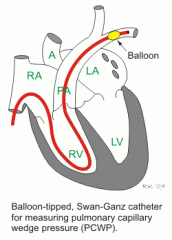
A way of measuring left atrial pressure by inserting a balloon through the RA -> RV -> PA until it reaches a smaller vessel. When the balloon is inflated the pressure on the distal side of the balloon will reach a pressure very similar to that in the right atrium
|

